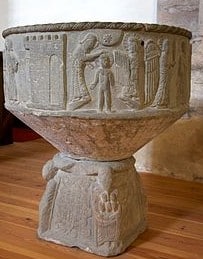
Elizabeth was just 3 days old, having been born on the 7th September, when she was processed along a carpet of green rushes from the Great Hall at Greenwich to the church1. The Letters and Papers, Foreign and Domestic, Henry VIII, contain a record of Elizabeth’s christening:-
“The mayor, Sir Stephen Pecock, with his brethren and 40 of the chief citizens, were ordered to be at the christening on the Wednesday following ; on which day the mayor and council, in scarlet, with their collars, rowed to Greenwich, and the citizens went in another barge.
All the walls between the King’s place and the Friars were hanged with arras, and the way strewed with rushes. The Friars’ church was also hanged with arras. The font, of silver, stood in the midst of the church three steps high, covered with a fine cloth, and surrounded by gentlewomen with aprons and towels about their necks, that no filth should come into it. Over it hung a crimson satin canopy fringed with gold, and round it was a rail covered with red say.
Between the choir and the body of the church was a close place with a pan of fire, to make the child ready in. When the child was brought to the hall every man set forward. The citizens of London, two and two ; then gentlemen, squires, and chaplains, the aldermen, the mayor alone, the King’s council, his chapel, in copes ; barons, bishops, earls ; the earl of Essex bearing the covered gilt basons ; the marquis of Exeter with a taper of virgin wax. The marquis of Dorset bare the salt. The lady Mary of Norfolk bare the chrisom, of pearl and stone. The officers of arms. The old duchess of Norfolk bare the child in a mantle of purple velvet, with a long train held by the earl of Wiltshire, the countess of Kent, and the earl of Derby. The dukes of Suffolk and Norfolk were on each side of the Duchess. A canopy was borne over the child by lord Rochford, lord Hussy, lord William Howard, and lord Thomas Howard the elder. Then ladies and gentlewomen.
The bishop of London and other bishops and abbots met the child at the church door, and christened it. The archbishop of Canterbury was godfather, and the old duchess of Norfolk and the old marchioness of Dorset godmothers. This done, Garter, with a loud voice, bid God send her long life. The archbishop of Canterbury then confirmed her, the marchioness of Exeter being godmother. Then the trumpets blew, and the gifts were given ; after which wafers, comfits, and hypocras were brought in. In going out the gifts were borne before the child, to the Queen’s chamber, by Sir John Dudley, lord Thos. Howard, the younger, lord Fitzwater, and the earl of Worcester. One side was full of the Guard and King’s servants holding 500 staff torches, and many other torches were borne beside the child by gentlemen. The mayor and aldermen were thanked in the King’s name by the dukes of Norfolk and Suffolk, and after drinking in the cellar went to their barge.”2
In his Chronicle of England, Charles Wriothesley writes that “and the morrowe after their was fiers[bonfires] made in London, and at everie fire a vessell of wyne[wine] for people to drinke for the said solempnitie.”3 but the Imperial ambassador, Eustace Chapuys, contradicts this in his report to Charles V on the 15th September, saying “the christening has been like her mother’s coronation, very cold and disagreeable, both to the Court and to the city, and there has been no thought of having the bonfires and rejoicings usual in such cases.”4 We know that Anne Boleyn’s coronation was lavish, so I’m not sure that we can believe Chapuys!
This royal princess was named Elizabeth and Eric Ives writes of how this name was chosen, rather than the name of one of her godmothers, “deliberately to identify her with the royal dynasty, especially Henry VIII’s mother.”5 Even though she was a girl, and not the longed for son and heir to the throne, her birth was celebrated in style and Henry and Anne were victorious. No-one knew then that this little girl would one day rule over England.
Notes and Sources
- The Life and Death of Anne Boleyn, Eric Ives, p185
- L&P vi. 1111
- A Chronicle of England During the Reigns of the Tudors, Charles Wriothesley, p23
- L&P vi. 1125
- Ives, p185










